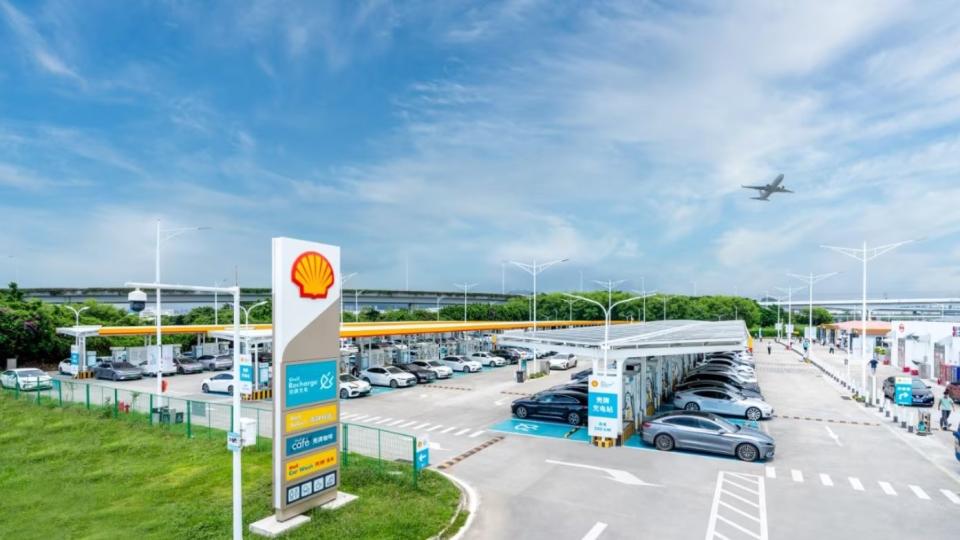Is Shell’s Largest EV Station a Sign of Things to Come?

Shell has opened its largest EV station in the world outside the airport in Shenzhen, China, with 258 fast-charging stalls.
The energy company is experimenting with converting gas stations to EV charging stations, complete with solar cells on canopies for extra power generation.
Some efforts are under way in the US to bring large charging plazas with dozens of connectors to the US East Coast, but such projects have yet to come online.
A charging station with a dozen or more stalls is still a rare sight in the US, found mostly along busy interstate routes in the west at the moment—exactly where you'd expect to see such a station. But how about a charging station with 258 fast-charging stalls?
That's exactly what Shell has opened last month near the airport in Shenzhen, China, in one of the country's largest cities. The station has already served over 3300 EVs every 24-hour cycle during its trial period prior to its full-scale launch in September, making it Shell's largest charging station in the country.
But the station is more than just a row of charging points. Shell's Recharge Shenzhen Airport EV Station offers a driver's lounge, vending machines, a Shell Cafe, and a convenience store. An, like many stations of its scale, it features solar panels, providing 300,000 kilowatt-hours of renewable energy every year.
"We know that EV drivers are looking for a charging experience that is fast, convenient and comfortable and this is reflected in the utilization rates of our sites in China, which are two to three times the local industry average," said István Kapitány, Shell’s Global Executive Vice President for Mobility.
Just when could we see stations like this in the US, at least at a fraction of this scale?
At the moment, there is only minimal movement in the charging industry in the US toward larger charging plazas with a dozen or so stalls, in addition to convenience stores and some other items commonly found at gas stations.
Part of the reason is that station builders do not want to get in the business of running a convenience store with a small cafe with staff, despite the fact that customers will be spending more time at such stations than drivers do at gas stations.
Another reason is that owners of convenience stores also haven't started to contract station builders to create such plazas in the first place, as the rate of EV adoption hasn't moved the needle in that direction, not counting some regional hot spots such as northern California.
And we are sensing a particular aversion to employing humans in these convenience stores, with a number of efforts focusing on elaborate vending machines.
Still, there are a few efforts being made in the direction of pairing large DC fast-charger plazas with convenience stores, at least in locations where it makes sense.
Electrify America is in the process of building stations that will feature up to 20 DC fast-chargers in addition to a small convenience store, with the first ones planned for Brooklyn and Manhattan, in addition to cities on the West Coast.
Revel is focusing on the East Coast as well with a 60-stall station planned for Maspeth, and one-half that size planned for the Bronx. Brooklyn's Red Hook district is also set to receive a 20-stall station.
Other automakers, notably Audi and Porsche, are experimenting with more of an airline lounge experience, having opened a number of reservations-only hubs.
Still, these are much smaller than Shell's Shenzhen station, if certainly a step ahead of what has been the typical EV station experience for the past decade, with zero snacks on site or even rain protection.
When it comes to Shell itself, the company has recently demonstrated a concept for a smaller but store-equipped station outside of China, revealing a station in London featuring nine 175-kW chargers that had been converted from a gas station.
EV adoption in London is certainly a few steps ahead of NYC at the moment, and it's a good preview of what we could see stateside in about five years, at least in the larger cities.
In the coming years, our hopes are for a fast-charging corridor between large cities that could enable interstate travel without even thinking about charger locations prior to departure. When one would not have to plan for a long road trip in an EV, that would be the ultimate sign of progress in the charging sphere. We're not there yet.
Will we see significant numbers of gas stations convert to EV stations in this decade, or will this process take longer? Let us know what you think.

